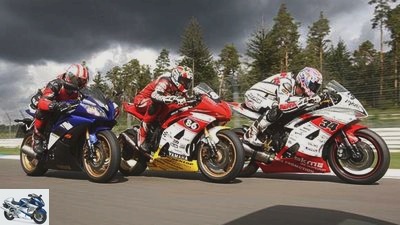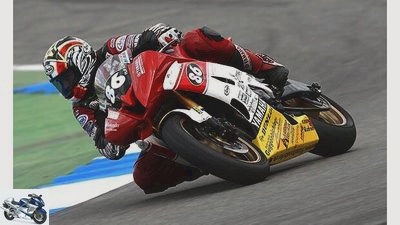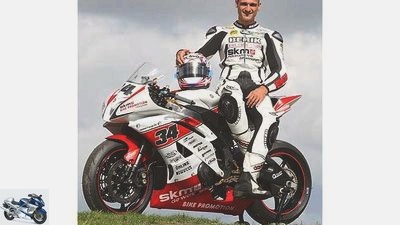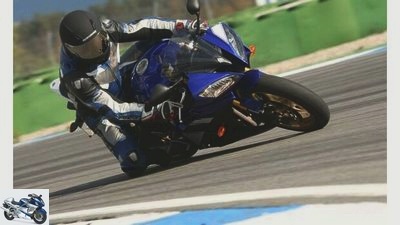Table of contents
- Comparison test: Yamaha YZF-R6 in three expansion stages R6 series vs. Cup vs. IDM bike
- Series R6 vs Cup vs IDM bike
- Yamaha Cup R6
- Yamaha IDM-R6
- Yamaha-R6 (series)
- Conclusion
- Rating Cup-R6
- Assessment IDM-R6
- Rating Yamaha YZF-R6 (Series)

Jahn
motorcycles
Comparison test: Yamaha YZF-R6 in three expansion stages
Comparison test: Yamaha YZF-R6 in three expansion stages
R6 series vs. Cup vs. IDM bike
Content of
Yamaha’s R6 is already a thoroughbred racing planer in series production and deservedly landed in first place in the big PS test winner comparison test in the race standings. How much can Filip Altendorfers Cup version and Pascal Eckhardt’s IDM bike add to this??
Sebastian Lang
January 18, 2009
Series R6 vs Cup vs IDM bike
The racing suits are stowed in the motorhome, the season is over. Supersport IDM driver Pascal Eckhardt and the newly crowned R6 Cup champion Filip Altendorfer sit relaxed in jeans and a shirt in the Hockenheim pit lane and discuss the differences between their Yamahas. Tires, chassis, engine? what does it bring, how much and where can it be used? Is the IDM machine really clearly superior to the cup version? And how does the series compare to that? A PS test should clarify these questions. A series R6 is quickly organized and placed alongside the two racing yams. Even when stationary, the motorcycles differ like day and night. With mirrors, indicators and the inconspicuous blue paintwork, the street bike looks almost good? a super athlete for everyday life.
Yamaha Cup R6

Jahn
It’s unbelievable how Filip Altendorfer can almost drive IDM times with perfectly normal road tires.
Altendorfers Cup machine looks a lot more like racing. Accessory cover, BOS complete exhaust system, Gilles pegs and handlebar stubs, steel flex lines. Everything that the strict regulations do not forbid has been trimmed for racing. This also includes the Ohlins TTX shock absorber, on which the driver is allowed to change the spring exactly once per season ?? as I said, the R6 Cup rules are strict. Accessory springs and other oil in the fork complete the conversion work on the chassis. On the drive side, a gear ratio shortened by one tooth should provide more propulsion. Small measure, noticeable effect. The red R6 screams through the parabolic steroids, turns and turns. Fourth gear, fifth gear, sixth gear. Shortly before the limiter, the braking point flies past the pilot. Straighten up and get into the iron. Can the cup machine be compressed properly and is surprisingly stable? Result of the very flat chassis geometry from Altendorfer with a fully inserted fork. Shift down, knees out, bend. This shows the downside of the chassis design trimmed for stability. The R6 falls into the curve rather unwillingly, needs noticeable strength from a medium lean angle and also wants to be kept firmly on course at the end of the curve. The pilot actually has other worries here. The Dunlop GP Racer rear tire, the weakest link in the cup chain, acknowledges hard acceleration with decreasing grip and brings significant unrest to the motorcycle.
That cannot be said of the chassis. The fork and shock absorber offer enough reserves in all situations and pamper you with good feedback. Only the front should respond a little more sensitively. Black and white flag, phase-out round. Time to think. It is unbelievable how someone can drive close to IDM times with the Dunlop GP Racer, actually more intended for the country road. It was not for nothing that Filip Altendorfer showed how much potential lies dormant in him at the season finale in Hockenheim in the Supersport race: He drove up from 30th to 18th place on Dunlop racing tires and undercut the time of the R6 Cup by almost two seconds. Back in the pits, Pascal Eckhardt, R6 Cup Champion of 2006, is already waiting. He too does not want to miss the opportunity to directly compare series, cup and IDM bikes. With visible anticipation, he takes over the cup machine, nods briefly in the direction of his IDM bike, calls out: “Have fun and remember, normal switching scheme” and hums off towards the pit exit.
| Technical data Cup-R6 |
Yamaha IDM-R6

Jahn
Pascal Eckhardt had a good laugh with this motorcycle. Performance, feedback, grip – the IDM-R6 is clearly superior to the other two in all areas.
Time to take a breather and take a closer look at number 34. The shift pattern is pretty much the only thing that still corresponds to the series on this motorcycle at first glance. Gilles handlebars with Renthal rubber grips and Pazzo levers for the hands, a Gilles footrest system with Quickshifter on the left and Motomaster Wave brake disc on the right for the feet. A standard fork with a modified shim package is intended to counteract the force of the Lucas brake pads; the shock absorber is identical to that of the cup machine. The electronics were also trimmed for racing. A kit-ECU and the corresponding wiring harness help the engine through changes to the injection, ignition angle, control of the variable funnel and throttle valve position in connection with the Akrapovic complete system to an impressive 136 crankshaft horsepower. In contrast to the 15:45 ratio from Altendorfer, Eckhardt drives with a 16-tooth pinion and a 43-tooth sprocket. A Bockers additional cooler should protect the little racing screamer from an overly hot head.
The IDM machine conveys a lot of trust right from the first few meters. The seating position is relaxed, the motor pushes forwards much more linearly and with more pressure than you are used to from series and cup bikes, the chassis responds sensitively and cleanly. Speed and driving pleasure increase quickly. The perfectly adjustable brake, the slipper clutch and the taut fork allow wonderful late braking points. You can also enjoy bending over. So an R6 has to turn. The IDM bike folds down playfully, sucks on the inside of the curve and stays on the tight line as if by itself. Accelerating out of the way is followed by another aha experience: Pirelli Diablo Supercorsa. A tire worthy of the R6. No twitching, no sliding, the 34 stubbornly stays on the targeted line and pulls the asphalt under itself with the linear emphasis of the 136 racing hp. The shock absorber is also of the stiff type and self-confidently braces itself between the swing arm and the rider’s rear. Eckhardt’s IDM bike has something in common with the series despite its strong racing-oriented character: a certain residual comfort. Even after many laps, racing is still fun on both machines.
| Technical data IDM-R6 |
Yamaha-R6 (series)

Jahn
Even in its original trim, the Yamaha R6 is a lot of fun. Their handling is better than that of the cup machine.
Switching to a production bike is difficult. While the standard R6’s brakes and handling are convincing, the final consequence is missing, especially with the chassis and tires. The series machine circles the Hockenheim circuit softly and somewhat imprecisely. This trust never arises, which Eckhardts 34 conveys from the first meter. The differences are also clearly noticeable in the engine. The production R6 struggled to advance up to 10,000 rpm, but then picked up quite a bit, but remained far behind the strong and light IDM machine. Compared to the Cup machine, the series R6 looks much better. Especially when turning in, she can distance herself positively from Altendorfer’s motorcycle. The better chassis and the shorter gear ratio ultimately decide in favor of the cup version, despite tires that take getting used to and poor handling.
| Technical specifications YZF-R6 (Series) |
Conclusion
Pascal Eckhardt’s IDM-R6 clearly wins the Yamaha internal comparison test. Precision, chassis, engine, tires ?? the number 34 is superior to the two sisters in all respects. It’s a lot closer between Filip Altendorfers Cup machine and the series. Both suffer from the tires that cannot cope with hard laps on the racetrack. The Cup-R6 scores above all with its better chassis, the few more horsepower and the shorter gear ratio. Its geometry, which is strongly geared towards stability, takes getting used to, however.
Rating Cup-R6

Jahn
Yamaha YZF-R6 (Cup)
PS judgment: 2nd place, 13 points
The cup version of the R6 ends up just before the series. With other tires and a more maneuverable set-up, the difference would be greater.
| valuation |
Assessment IDM-R6

Jahn
Yamaha YZF-R6 (IDM bike)
PS judgment: 1st place, 18 points
The IDM machine does everything better than its competitors and wins the test, but at 28,000 euros it is also very expensive.
| valuation |
Rating Yamaha YZF-R6 (Series)

Jahn
Yamaha YZF-R6 (Series)
PS judgment: 3rd place, 12 points
For a street motorcycle, the series R6 cuts a very good figure on the racetrack. Only in direct comparison with racers does it lose points.
| valuation |
Related articles
-
Comparison test: Kawasaki ZX-6R in three expansion stages
Jahn motorcycles Comparison test: Kawasaki ZX-6R in three expansion stages Comparison test: Kawasaki ZX-6R in three expansion stages Queen, King, Ace…
-
fact motorcycles Comparison test: Honda CBR 600 RR, Kawasaki ZX-6R, Suzuki GSX-R 600, Triumph Daytona 675, Yamaha YZF-R6 Comparison test: Honda CBR 600…
-
Comparison test Kawasaki Ninja ZX-6R, Triumph Daytona 675, Yamaha YZF-R6
Fact 9 pictures triumph 1/9 Triumph Daytona 675 triumph 2/9 Triumph Daytona 675 triumph 3/9 Triumph Daytona 675 triumph 4/9 Triumph Daytona 675 triumph…
-
Comparison test between Suzuki DL 1000 V-Strom and Yamaha TDM 900
Artist motorcycles Comparison test between Suzuki DL 1000 V-Strom and Yamaha TDM 900 Comparison test between Suzuki DL 1000 V-Strom and Yamaha TDM 900…
-
Bilski motorcycles Comparison test: KTM 990 Super Duke, Moto Morini Corsaro 1200 Veloce, Triumph Speed Triple, Yamaha FZ1 Comparison test: KTM 990…
-
Comparison test: Japanese naked bikes
Jahn motorcycles Comparison test: Japanese naked bikes Comparison test: Japanese naked bikes Go big Content of …or go home! Big bore instead of boring,…
-
Comparison test MV Agusta Turismo Veloce 800 and Yamaha MT-09 Tracer
Bilski 19th pictures MOTORCYCLE 1/19 Power on the crankshaft. Measurements on the Dynojet roller test stand 250, corrected according to 95/1 / EG,…
-
Comparison test Kawasaki Versys 650, Suzuki V-Strom 650 and Yamaha Tracer 700
www.factstudio.de 27 pictures www.factstudio.de 1/27 Crossover comparison test with the Kawasaki Versys 650, Suzuki V-Strom 650 and Yamaha Tracer 700….
-
Comparison test Ducati 1098S, Honda Fireblade, KTM 1190 RC8, Triumph Daytona 675, Yamaha YZF-R6
Jahn motorcycles Comparison test Ducati 1098S, Honda Fireblade, KTM 1190 RC8, Triumph Daytona 675, Yamaha YZF-R6 Comparison test Ducati 1098S, Honda…
-
Comparison test: Honda Hornet, Kawasaki Z 750, Suzuki GSR 600
Jahn motorcycles Comparison test: Honda Hornet, Kawasaki Z 750, Suzuki GSR 600 Comparison test: Honda Hornet, Kawasaki Z 750, Suzuki GSR 600 ABS shooters…